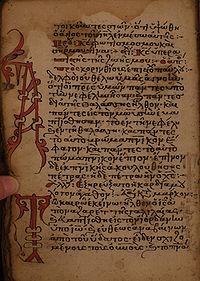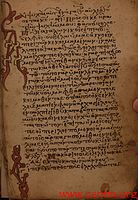Description
The codex contains 15 lessons from the Gospels, Acts of the Apostles, and Epistles, and three from the Old Testament lectionary (Evangelistarium, Apostolarium), with some lacunae. [5] The text is written in Greek minuscule letters, on 177 paper leaves – for the New Testament – (21.3 cm by 14.5 cm), in one column per page, 26 lines per page. [1] [2] The initial letters are rubricated. The whole codex has 228 leaves. Two leaves numbered 20, two leaves numbered 21, 29r not numbered, 35r not numbered, 64r has two numbers, 66r has two numbers. [4] It was written by several various hands. [3] The initial letters are beautifully decorated.

Gospel originally meant the Christian message itself, but in the 2nd century it came to be used for the books in which the message was set out. The four canonical gospels — Matthew, Mark, Luke and John — were probably written between AD 66 and 110, building on older sources and traditions, and each gospel has its own distinctive understanding of Jesus and his divine role. All four are anonymous, and it is almost certain that none were written by an eyewitness. They are the main source of information on the life of Jesus as searched for in the quest for the historical Jesus. Modern scholars are cautious of relying on them unquestioningly, but critical study attempts to distinguish the original ideas of Jesus from those of the later authors. Many non-canonical gospels were also written, all later than the four, and all, like them, advocating the particular theological views of their authors.

Acts of the Apostles, often referred to simply as Acts, or formally the Book of Acts, is the fifth book of the New Testament; it tells of the founding of the Christian church and the spread of its message to the Roman Empire.

The Old Testament is the first part of Christian Bibles, based primarily upon the Hebrew Bible, a collection of ancient religious writings by the Israelites believed by most Christians and religious Jews to be the sacred Word of God. The second part of the Christian Bible is the New Testament.
Accents and breathings are inaccurate. Errors of itacisms are frequent, especially the interchange of ο and ω. Lessons from the Epistles and Gospels about in equal numbers. From the Septuaginta occur as lessons Isaiah 12:3-6; 35:1-10; 55:1-13; Ps 137:1-6. [6]
Iotacism is the process by which a number of vowels and diphthongs in Ancient Greek converged in pronunciation so they all now sound like iota in Modern Greek. In the case of the letter eta specifically, the process is known as itacism.
Omicron is the 15th letter of the Greek alphabet. In the system of Greek numerals it has a value of 70. This letter is derived from the Phoenician letter ayin . In classical Greek, omicron represented the sound in contrast to omega and ου. In modern Greek, omicron represents the mid back rounded vowel. Letters that arose from omicron include Roman O and Cyrillic O.
Omega is the 24th and last letter of the Greek alphabet. In the Greek numeric system/Isopsephy (Gematria), it has a value of 800. The word literally means "great O", as opposed to omicron, which means "little O".
Some reading are remarkable. [6]
- Matthew 1:5 – εκ της ραχαβ and εκ της ρουθ
- Matthew 1:16 – ματθαν δε εγεννησε των ιακωβ ιακωβ δε
- Luke 2:3 – εκαστος
- Luke 2:5 – εγκυω ] εγγυω
History
Scrivener dated the manuscript to the 13th century, [3] Gregory dated it to the 15th century. It has been assigned by the Institute for New Testament Textual Research (INTF) to the 15th century. [1] [2]
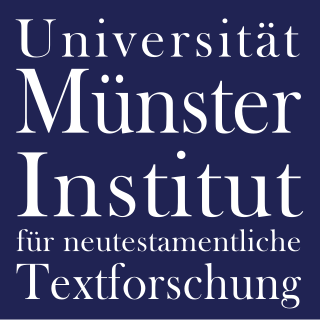
The Institute for New Testament Textual Research at the University of Münster, Westphalia, Germany, is to research the textual history of the New Testament and to reconstruct its Greek initial text on the basis of the entire manuscript tradition, the early translations and patristic citations; furthermore the preparation of an Editio Critica Maior based on the entire tradition of the New Testament in Greek manuscripts, early versions and New Testament quotations in ancient Christian literature. Under Kurt Aland's supervision, the INTF collected almost the entire material that was needed - Manuscript count 1950: 4250; 1983: 5460; 2017: approx. 5800.
Of the early history of the codex nothing is known until 1864, when it was in the possession of a dealer at Janina in Epeiros. It was then purchased from him by a representative of Baroness Burdett-Coutts (1814–1906), a philanthropist, [7] along with other Greek manuscripts (among them Lectionary 214-227). [5] They were transported to England in 1870-1871. [8] The manuscript was presented by Burdett-Coutts to Sir Roger Cholmely's School, and was housed at the Highgate (Burdett-Coutts III. 53), in London. [5]

Ioannina, often called Yannena within Greece, is the capital and largest city of the Ioannina regional unit and of Epirus, an administrative region in north-western Greece. Its population is 112,486, according to 2011 census. It lies at an elevation of approximately 500 metres above sea level, on the western shore of lake Pamvotis (Παμβώτις). Ioannina is located 410 km (255 mi) northwest of Athens, 260 kilometres southwest of Thessaloniki and 80 km east of the port of Igoumenitsa in the Ionian Sea.

Angela Georgina Burdett-Coutts, 1st Baroness Burdett-Coutts, born Angela Georgina Burdett, was a nineteenth-century philanthropist, the daughter of Sir Francis Burdett, 5th Baronet and Sophia, formerly Coutts, daughter of banker Thomas Coutts. In 1837 she became one of the wealthiest women in England when she inherited her grandfather's fortune of around £1.8 million following the death of her stepgrandmother, Harriot Mellon. She joined the surnames of her father and grandfather, by royal licence, to become Burdett-Coutts. Edward VII is reported to have described her as, "[a]fter my mother, the most remarkable woman in the kingdom."
Lectionary 214, designated by siglum ℓ214, is a Greek manuscript of the New Testament, on parchment. Palaeographically it has been assigned to the 12th century. Scrivener labelled it by 239evl.
The manuscript was added to the list of New Testament manuscripts by Scrivener (number 253) and Gregory (number 228). Gregory saw it in 1883. [5] In 1922 it was acquired for the University of Michigan. The manuscript was described by K. W. Clark in 1937. [9]

Caspar René Gregory was an American-born German theologian.
The manuscript is not cited in the critical editions of the Greek New Testament (UBS3). [10]
The codex is housed at the University of Michigan (Ms. 43) in Ann Arbor, Michigan. [1] [2]
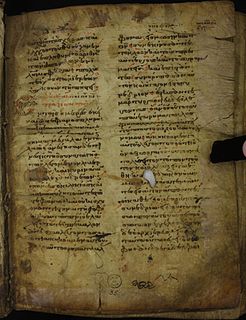
Lectionary 170, designated by siglum ℓ 170 is a Greek manuscript of the New Testament, on parchment leaves. Palaeographically it has been assigned to the 14th century.
Scrivener dated it to the 12th or 13th century. Formerly it was labelled as Lectionary 68a. Scrivener by 65a.
Minuscule 538, ε 335, is a Greek minuscule manuscript of the New Testament on a parchment. Dated palaeographically to the 12th or 13th century. Formerly it was labelled as Wd and 552 (Scrivener).
The manuscript is lacunose.
It was adapted for liturgical use.
Minuscule 534, 547, ε 333, is a Greek minuscule manuscript of the New Testament, on a paper. Palaeographically it has been assigned to the 13th century. The manuscript was adapted for liturgical use. It is lacunose.

Minuscule 535, 548 (Scrivener), ε 140, is a Greek minuscule manuscript of the New Testament, on a parchment, dated to the 12th century. It was adapted for liturgical use, with full marginalia.
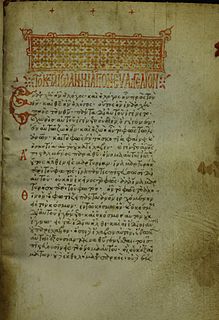
Minuscule 536, δ 264, is a Greek minuscule manuscript of the New Testament, on parchment. Palaeographically it has been assigned to the 13th century.
Scrivener labeled it by number 549.
Several pages of the manuscript were lost. Incomplete marginalia. The manuscript is available in a digital form on the internet.

Minuscule 537, ε 334, is a Greek minuscule manuscript of the New Testament, on a parchment. Palaeographically it has been assigned to the 12th century. Scrivener labelled it by number 550. The manuscript was prepared for liturgical use, its marginalia are not complete. It has survived until the present day in complete condition.
Minuscule 540, ε 334, is a Greek minuscule manuscript of the New Testament, on a parchment. Palaeographically it has been assigned to the 14th century.
Scrivener labelled it by number 553.
It has marginalia. The manuscript has no complex context.

Minuscule 544, 557, ε 337, is a Greek minuscule manuscript of the New Testament, on parchment. The manuscript has complex contents. Palaeographically it has been assigned to the 13th century.
It was not adapted for liturgical use.

Minuscule 546, ε 511, is a Greek minuscule manuscript of the New Testament, on parchment. It is dated palaeographically to the 13th century. It has some marginalia, the scribe has made numerous errors.

Lectionary 216, designated by siglum ℓ 216 is a Greek manuscript of the New Testament, on parchment. Palaeographically it has been assigned to the 13th century.
Scrivener labelled it by 251evl and 64apost.
Lectionary 217, designated by siglum ℓ 217 is a Greek manuscript of the New Testament, on parchment. Palaeographically it has been assigned to the 13th century.
Scrivener labelled it by 241evl.
Lectionary 218, designated by siglum ℓ 218 is a Greek manuscript of the New Testament, on paper. Palaeographically it has been assigned to the 15th century.
Scrivener labelled it by 242evl.

Lectionary 220, designated by siglum ℓ 220 is a Greek manuscript of the New Testament, on parchment. Palaeographically it has been assigned to the 13th century.
Frederick Henry Ambrose Scrivener labelled it by 244evl.
The manuscript is lacunose.

Lectionary 223, designated by siglum ℓ 223 is a Greek manuscript of the New Testament, on paper. Palaeographically it has been assigned to the 15th century.
Frederick Henry Ambrose Scrivener labelled it by 252evl.
It contains much additional material, liturgical and secular.
Lectionary 224, designated by siglum ℓ 224 is a Greek manuscript of the New Testament, on parchment. Palaeographically it has been assigned to the 14th century.
Scrivener labelled it by 247evl. The manuscript has complex contents.

Lectionary 225, designated by siglum ℓ 225 is a Greek manuscript of the New Testament, on paper. Palaeographically it has been assigned to the 15th century.
Scrivener labelled it by 248evl.
The manuscript has complex contents.

Lectionary 226, designated by siglum ℓ 226 is a Greek manuscript of the New Testament, on parchment. Palaeographically it has been assigned to the 14th century. Scrivener labelled it by 249evl.
Some leaves of the manuscript were lost, and some leaves have survived in a fragmentary condition.
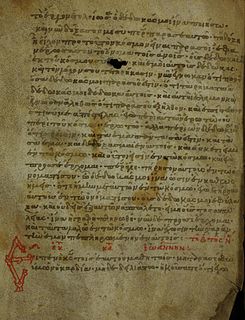
Lectionary 227, designated by siglum ℓ 227 is a Greek manuscript of the New Testament, on parchment. Palaeographically it has been assigned to the 14th century.
Scrivener labelled it by 250evl.
Many leaves of the manuscript were lost, some leave have survived in a fragmentary condition.

Lectionary 313 (Gregory-Aland), designated by siglum ℓ 313 is a Greek manuscript of the New Testament, on parchment. Palaeographically it has been assigned to the 14th-century. The manuscript has survived in a fragmentary condition.
Lectionary 315 (Gregory-Aland), designated by siglum ℓ 315 is a Greek manuscript of the New Testament, on paper. Palaeographically it has been assigned to the 16th century. The manuscript has been lost.



